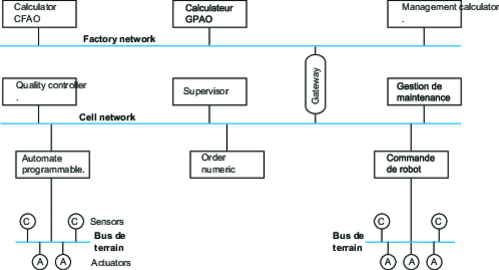Overview
Read this article from a comprehensive knowledge base, updated and supplemented with articles reviewed by scientific committees.
Read the articleAUTHORS
-
Francis COTTET: University Professor (ENSMA, Poitiers Futuroscope) - Engineer, Institut national polytechnique de Grenoble - Doctor of Science
-
Joëlle DELACROIX: Senior lecturer (Conservatoire national des arts et métiers, Paris) - Doctorate in computer science from Pierre-et-Marie-Curie University
-
Claude KAISER: Professor (Conservatoire national des arts et métiers, Paris) - École polytechnique engineer, marine engineer - Doctor of Science
-
Zoubir MAMMERI: University Professor (Paul-Sabatier University, Toulouse) - Engineer, PhD in computer science Qualified to direct research
INTRODUCTION
The complexity of the processes to be controlled or supervised, the large number of data and events to be processed, the geographical distribution of processes, and the arrival on the market of industrial local area networks over the last few years have all led to a rethinking of centralized real-time applications. Today, the notion of distributed real-time architectures is widely accepted in industrial circles. By way of illustration, the application domains that commonly make use of real-time and distributed systems are :
telecommunications (switching systems, etc.) ;
the medical field (assistance and monitoring of patients, etc.);
inspection of vehicle equipment (engine, brakes, suspension, etc.);
urban traffic control and regulation ;
industries (process control) ;
military applications (missile trajectory tracking, etc.);
aerospace (satellite tracking, automatic piloting, etc.);
multimedia (teleconferencing, teleshopping, etc.) ;
home automation (home security, etc.).
A computer system designed to control or supervise operations is usually made up of several processing units (computers or programmable logic controllers), sensors, actuators, peripherals for visualization and dialogue with operators. All these elements are interconnected by a network, or a whole host of interconnected networks (industrial networks, office networks, field buses, etc.), as shown in figure 1 . This type of system is known as a distributed real-time system.
In this type of system, task and message scheduling play a fundamental role. Centralized task scheduling is covered in the article "Real-time scheduling. Centralized scheduling" of this treatise. Message scheduling is the subject of this article.

Exclusive to subscribers. 97% yet to be discovered!
You do not have access to this resource.
Click here to request your free trial access!
Already subscribed? Log in!

The Ultimate Scientific and Technical Reference
This article is included in
Control and systems engineering
This offer includes:
Knowledge Base
Updated and enriched with articles validated by our scientific committees
Services
A set of exclusive tools to complement the resources
Practical Path
Operational and didactic, to guarantee the acquisition of transversal skills
Doc & Quiz
Interactive articles with quizzes, for constructive reading
Real-time scheduling
References
Exclusive to subscribers. 97% yet to be discovered!
You do not have access to this resource.
Click here to request your free trial access!
Already subscribed? Log in!

The Ultimate Scientific and Technical Reference